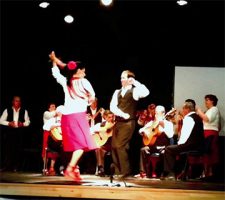The Fandango was declared an Asset of Cultural Interest in 2010, it is one of the roots of flamenco. At the end of the 18th century, the first farmhouses were built on the River de la Miel, on the eastern border of Nerja with Granada, and there the Fandangos Cortijeros was born and were from then on usually danced on holidays.
Fandango can both be sung and danced and is traditionally accompanied by guitars, castanets, or hand-clapping. Fandango is a lively couples dance originating in Spain. The earliest fandango melody is found in the anonymous “Libro de diferentes cifras de guitarra” from 1705, and the earliest description of the dance itself is found in a 1712 letter by Martín Martí, a Spanish priest.
This course to learn to dance the fandangos cortijeros of the Río de la Miel is advertised to anyone who wishes to participate, free of charge.
Sponsored by the Diputación Provincial de Málaga, it is an initiative of the Asociación Malagueña Entremares to rediscover the traditional folklore the province of Malaga
It is hoped that many more people will be embracing this lively traditional dance. Courses will begin on February 6 and will be held every Tuesday from 5:00 pm to 7:00 pm at the Municipal School of Music and Dance.
Encarnación López Sánchez and María Arellano González, from the folkloric group of the Río de la Miel, will be in charge of teaching this course.
Interested persons can register, before February 5, at Centro Cultural Villa de Nerja, at C / Granada 45, or at the Municipal School itself, at C / Carabeo.

